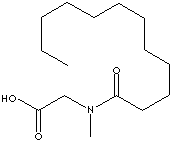| CAS
NO. |
97-78-9 |

|
| EINECS
NO. |
202-608-3 |
| FORMULA |
C15H29NO3 |
| MOL
WT. |
271.40 |
|
H.S.
CODE
|
|
|
SMILES |
|
|
TOXICITY
|
|
| SYNONYMS |
N-methyl-N-(1-oxododecyl)-Glycine; Lauroyl
sarcosine; |
| N-Cocoyl Sarcosinate; Lauroyl Sarcosinate;
Sarcosyl L; Crodasinic L; N-Lauroylsarkosin
(German); N-Lauroilsarcosina (Spanish); N-Lauroylsarcosine
(French); |
|
CLASSIFICATION
|
|
|
PHYSICAL AND CHEMICAL PROPERTIES
|
| PHYSICAL
STATE |
Pale yellow crystalline solid |
|
MELTING
POINT
|
34
- 37 C |
| BOILING
POINT |
|
| SPECIFIC GRAVITY |
0.97
- 0.99 |
|
SOLUBILITY
IN WATER
|
|
| pH |
|
| VISCOSITY |
|
|
AUTOIGNITION |
|
|
REFRACTIVE
INDEX
|
|
| NFPA RATINGS |
Health: 1; Flammability: 0; Reactivity: 0 |
| FLASH
POINT |
|
| STABILITY |
Stable
under ordinary conditions |
|
APPLICATIONS
|
|
Sarcosine , also known as methyl-glycoccoll, is an amino acid intermediate
naturally found in the metabolism of choline to glycine. Commercially, synthetic
sarcosine is obtained by the reaction of methylamine with monochloracetic acid.
It is adeliquescent crystal; sweet taste; dissolve in water,
slightly soluble in alcohol; decomposes at 208 C. It is used in manufacturing
biodegradable surfactants and toothpastes as well as in biological
applications. Sarcosinate Surfactants are mild, biodegradable anionic surfactants derived
from fatty acids and sarcosine (amino acid). These
compounds fovor lather building and resistance to sebum
delathering in cleaners, polymers, industrial chemicals, petroleum and lubricant
products. |
| SALES
SPECIFICATION |
|
APPEARANCE
|
Pale yellow crystalline solid |
|
ACTIVE
MATTER
|
94.0%
min
|
|
FREE
FATTY ACID
|
6.0%
max
|
|
COLOR
( GARDNER)
|
2
max
|
| TRANSPORTATION |
| PACKING |
25kgs
in bag |
| HAZARD CLASS |
|
| UN
NO. |
|
PRICE
INFORMATION
|
|
|
